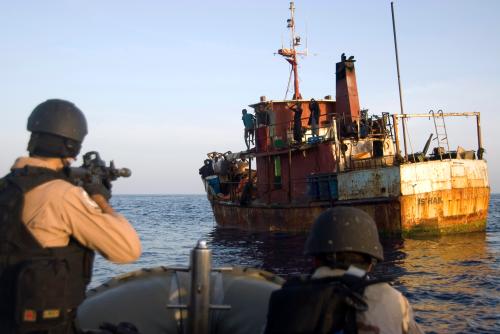In recent weeks, a number of attacks by Somali pirates have taken place, after a noticeably calm five-year period in the region. Last Tuesday, a Pakistani cargo vessel carrying food was highjacked off the coast of Somalia. This attack follows one from last month, when Somali pirates hijacked an oil tanker with eight Sri Lankan crewmembers; the attack marked the first successful capture of a large commercial ship by Somali pirates in the last five years. The tanker—a United Arab Emirates property—while traveling from Djibouti to Mogadishu, was diverted to a port in Alula, a small town in Puntland, a semi-autonomous region in northeast Somalia. This increase goes against the experience of recent years (Figure 1), where attacks by Somali pirates considerably declined after 2012. The decline in piracy has been partly attributed to an improvement of patrol efforts off the Somali coast, notably by the European Union Naval Force, which manages the anti-piracy efforts in the region.
Figure 1: Attacks (actual and attempted) by Somali pirates
 *Year to date
*Year to date
Note: Includes Gulf of Aden, Indian Ocean, Red Sea, Arabian Sea, Gulf of Oman, Somalia and Oman.
Source: ICC International Maritime Bureau.
Illegal fishing in Somali waters
One of the key underlying economic reasons of piracy in Somalia is the depletion of seafood resources through illegal fishing by foreign companies. The pirates who captured the UAE oil tanker last month claimed to be fishermen whose equipment was destroyed by illegal fishing vessels. A local official for a Puntland anti-piracy agency confirmed that the attack is linked to illegal fishing along the Somali coast, a problem that has existed for a while. While the issue was temporarily solved amid the implementation of aid programs, which replenished Somali fisheries, the depletion of Somalia’s seafood stock had pushed workers who depended on fishing for a livelihood toward piracy.
In 2009, a Time magazine article highlighted the transformation of Somali waters into a “free-for-all” fishing site where international fleets illegally collected more than $300 million worth of seafood. Foreign vessels have been increasingly present in Somali waters, with seafood captures doubling or even tripling those of Somali fishermen (Figure 2).
Figure 2: Estimated catch by foreign vessels and Somali vessels in Somali waters, 1981–2013
Source: Securing Somali Fisheries, Secure Fisheries, 2015
The Somali law does prohibit foreign ships from fishing within 15 miles of the coast, with the aim of protecting small-scale fishers. The country has also banned other destructive fishing methods, such as bottom trawling— a practice where the ship drags a fishing net across the seafloor, catching everything in its path. Still, the lack of a regulatory maritime entity in the country has enabled the continuation of illegal fishing in the region.
In addition to violations by foreign vessels, instances of corruption on the Somali side have also contributed to the depletion of fish stocks in the region. Reports state that Puntland’s government has sold $10 million worth of fishing licenses to China, going against the Somali law, which states that fishing permits must be purchased through the central Somali government. In addition to illegal fishing and corruption, other factors behind the resurgence of piracy in the region include drought and famine.
For more information on Piracy in Africa, please read this piece by Brookings Senior Fellow Vanda Felbab-Brown on “Dealing With Piracy Off The Coast Of Somalia And In The Gulf Of Guinea.”
For more information on Piracy in Somalia, please read a piece by Amadou Sy and Jessica Smith titled “Captain Phillips and the Drivers of Piracy in East Africa and Somalia.”








Commentary
Figures of the week: Piracy and illegal fishing in Somalia
April 12, 2017